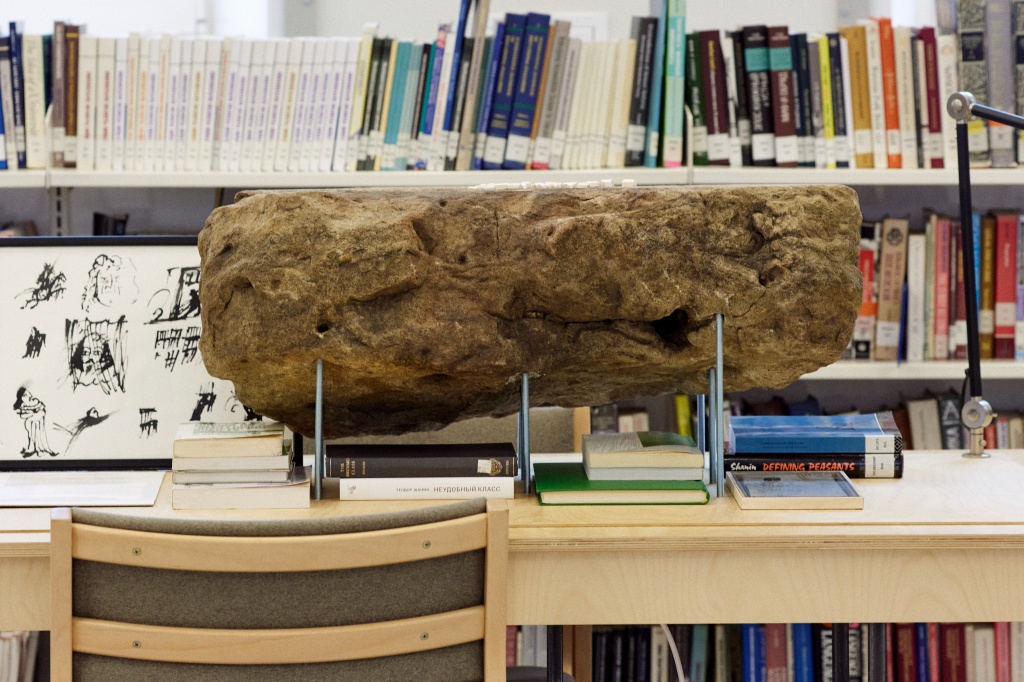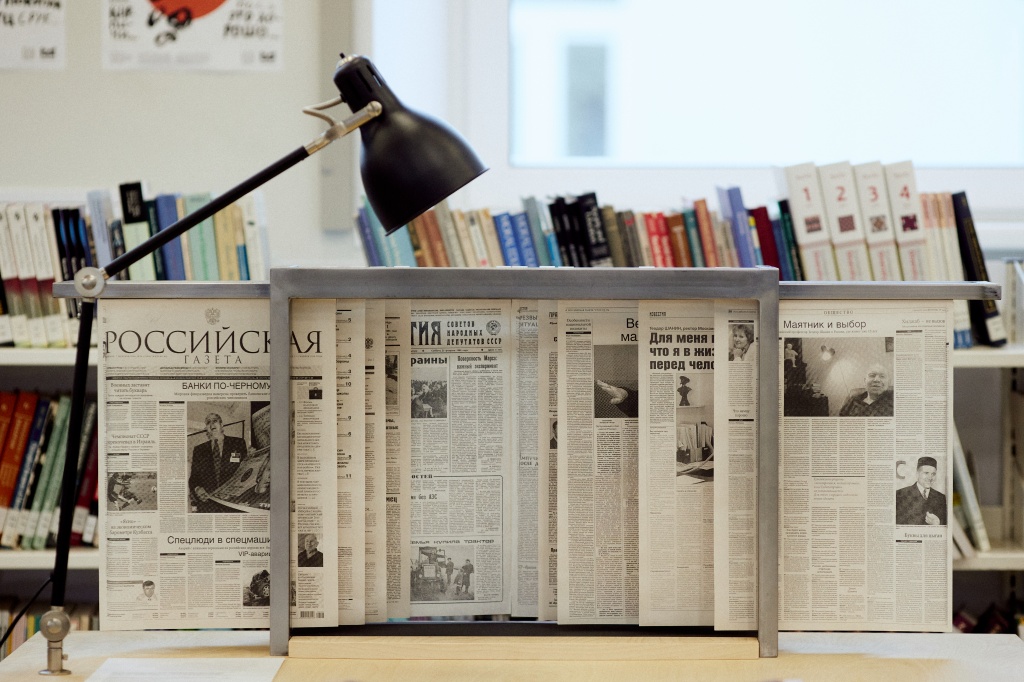Today, the ‘Teodor’s Islands’ exposition opens for MSSES residents in the library. A series of curated tours of the exhibition will be held after the New Year’s holidays. The official opening will take place on 4 February.
Today, the Teodor Shanin non-museum – the ‘Teodor’s Islands’ exposition – opens up to visitors in our library as part of the Shanin space project. In September, the project won the Third Grant competition of museum initiatives and exhibition projects of the Russian Jewish Congress.
The exposition is available in the preview format. Everyone interested can visit it on their own*. Due to the pandemic, we are currently unable to organise the opening and invite over 50 people, and we are confident that the number of those willing to come would be much higher. That is why the exposition now resides in the space of the MSSES library, where it will remain for quite a while. If everything goes according to plan, always.
A year and a half ago, we started discussing ways to commemorate Teodor Shanin and came to the conclusion that we needed something more complex than a memorial study or a plaque. The project manager Olga Karpova determined that the project has to be something more of a physical expression. That’s how the word “non-museum” came to be. Nadya Pantyulina, the project curator, studied a multitude of materials, listened to dozens of hours of lectures and interviews, and had conversations with lots of people to assemble the non-museum in the form of six ‘Teodor’s Islands’. The architectural embodiment was created by the architects Kiril Ass and Nadya Korbut. The exposition was beautifully constructed under the direction of Kamil Zhurakulov.
The “Islands” are now set in the library. They are six desks one can work behind. Five of them have desk lamps, and all of them have extra sockets below the tabletop. The desks are easily recognisable because of their metal trusses – an engineering support system that ensures robustness, much like the world is built upon the combined humanistic ideas and the work carried out for their realisation. The art of creation and Teodor’s ideas brought out to the surface – that’s the main symbolic meaning of the “islands”.
Today, the Teodor Shanin non-museum – the ‘Teodor’s Islands’ exposition – opens up to visitors in our library as part of the Shanin space project. In September, the project won the Third Grant competition of museum initiatives and exhibition projects of the Russian Jewish Congress.
The exposition is available in the preview format. Everyone interested can visit it on their own*. Due to the pandemic, we are currently unable to organise the opening and invite over 50 people, and we are confident that the number of those willing to come would be much higher. That is why the exposition now resides in the space of the MSSES library, where it will remain for quite a while. If everything goes according to plan, always.
A year and a half ago, we started discussing ways to commemorate Teodor Shanin and came to the conclusion that we needed something more complex than a memorial study or a plaque. The project manager Olga Karpova determined that the project has to be something more of a physical expression. That’s how the word “non-museum” came to be. Nadya Pantyulina, the project curator, studied a multitude of materials, listened to dozens of hours of lectures and interviews, and had conversations with lots of people to assemble the non-museum in the form of six ‘Teodor’s Islands’. The architectural embodiment was created by the architects Kiril Ass and Nadya Korbut. The exposition was beautifully constructed under the direction of Kamil Zhurakulov.
The “Islands” are now set in the library. They are six desks one can work behind. Five of them have desk lamps, and all of them have extra sockets below the tabletop. The desks are easily recognisable because of their metal trusses – an engineering support system that ensures robustness, much like the world is built upon the combined humanistic ideas and the work carried out for their realisation. The art of creation and Teodor’s ideas brought out to the surface – that’s the main symbolic meaning of the “islands”.
 Photo by A. Zamyatina
Photo by A. Zamyatina Photo by A. Zamyatina
Photo by A. ZamyatinaDescription cards on the desks will help the visitors recognise the underlying meanings of each “island”. You won’t be able to see the photographs under the thin sheets of tracing paper without touching them because the heritage can’t exist without interaction – it’s fragile and fading. Many of the clues to understanding it can be found on one of the desks, in the photographs and texts of the book Teodor had worked on for at least 10 years – the book that has never been published in Russian. Next to it is a phone booth speaking in Teodor’s voice. The booth is small and we are large – it’s our turn to pick up ideas and search for goals of social significance to realise them.
The students of RANEPA’s Design School of the Institute of Social Sciences and “Iskra” workshop studying under Anna Skrzhinskaya used posters to show what they think and how they feel Teodor as well as social issues in our society.
We will announce the start of registration for curated tours after the holidays. On 4 February, the Memorial Day, a full Shanin Space Day programme will be held in the library with the project seminar, meetings, discussions, a concert, and tea parties that we couldn’t organise in October due to the epidemiological situation.
You can explore the Shanin Space project – it now has a physical part. And one of the main and honest findings of the project was that the work is only just beginning and the exposition has become its visible perceptible materialised start. There’s considerable work ahead, and we invite and will keep engaging the whole MSSES community in it.
As it turned out, Teodor Shanin wasn’t particularly fond of things. He only had a few favourite items, cups, and pens that we see in classic museums. What remains is texts, papers, lectures, books, and followers who convey and promote his values. We’ve started putting together a large digital archive about all this. Teodor’s assistant Maria Pralnikova, chronicler of the life in MSSES Alexander Artamonov, Yulia Arseeva who studied Teodor’s exile to Altai, and 27 MSSES residents, who have responded to the invitation for an interview, have already participated in the project. Alexander Nikulin, Valery Vinogradsky, and Pyotr Kamenchenko provided their archival footage. St Philaret’s Institute provided Teodor’s attributed archive. The ROSPHOTO staffer Alexey Tikhonov – with support from the Russian Jewish Congress – has developed a multi-functional platform, which needs to be filled, as part of the Shanin Space project. The project is managed by the MSSES library director Veronika Khomyakova.
#shaninspace
*Outside guests can get a pass for the exposition by sending a request to biblioteka@universitas.ru
The students of RANEPA’s Design School of the Institute of Social Sciences and “Iskra” workshop studying under Anna Skrzhinskaya used posters to show what they think and how they feel Teodor as well as social issues in our society.
We will announce the start of registration for curated tours after the holidays. On 4 February, the Memorial Day, a full Shanin Space Day programme will be held in the library with the project seminar, meetings, discussions, a concert, and tea parties that we couldn’t organise in October due to the epidemiological situation.
You can explore the Shanin Space project – it now has a physical part. And one of the main and honest findings of the project was that the work is only just beginning and the exposition has become its visible perceptible materialised start. There’s considerable work ahead, and we invite and will keep engaging the whole MSSES community in it.
As it turned out, Teodor Shanin wasn’t particularly fond of things. He only had a few favourite items, cups, and pens that we see in classic museums. What remains is texts, papers, lectures, books, and followers who convey and promote his values. We’ve started putting together a large digital archive about all this. Teodor’s assistant Maria Pralnikova, chronicler of the life in MSSES Alexander Artamonov, Yulia Arseeva who studied Teodor’s exile to Altai, and 27 MSSES residents, who have responded to the invitation for an interview, have already participated in the project. Alexander Nikulin, Valery Vinogradsky, and Pyotr Kamenchenko provided their archival footage. St Philaret’s Institute provided Teodor’s attributed archive. The ROSPHOTO staffer Alexey Tikhonov – with support from the Russian Jewish Congress – has developed a multi-functional platform, which needs to be filled, as part of the Shanin Space project. The project is managed by the MSSES library director Veronika Khomyakova.
#shaninspace
*Outside guests can get a pass for the exposition by sending a request to biblioteka@universitas.ru

